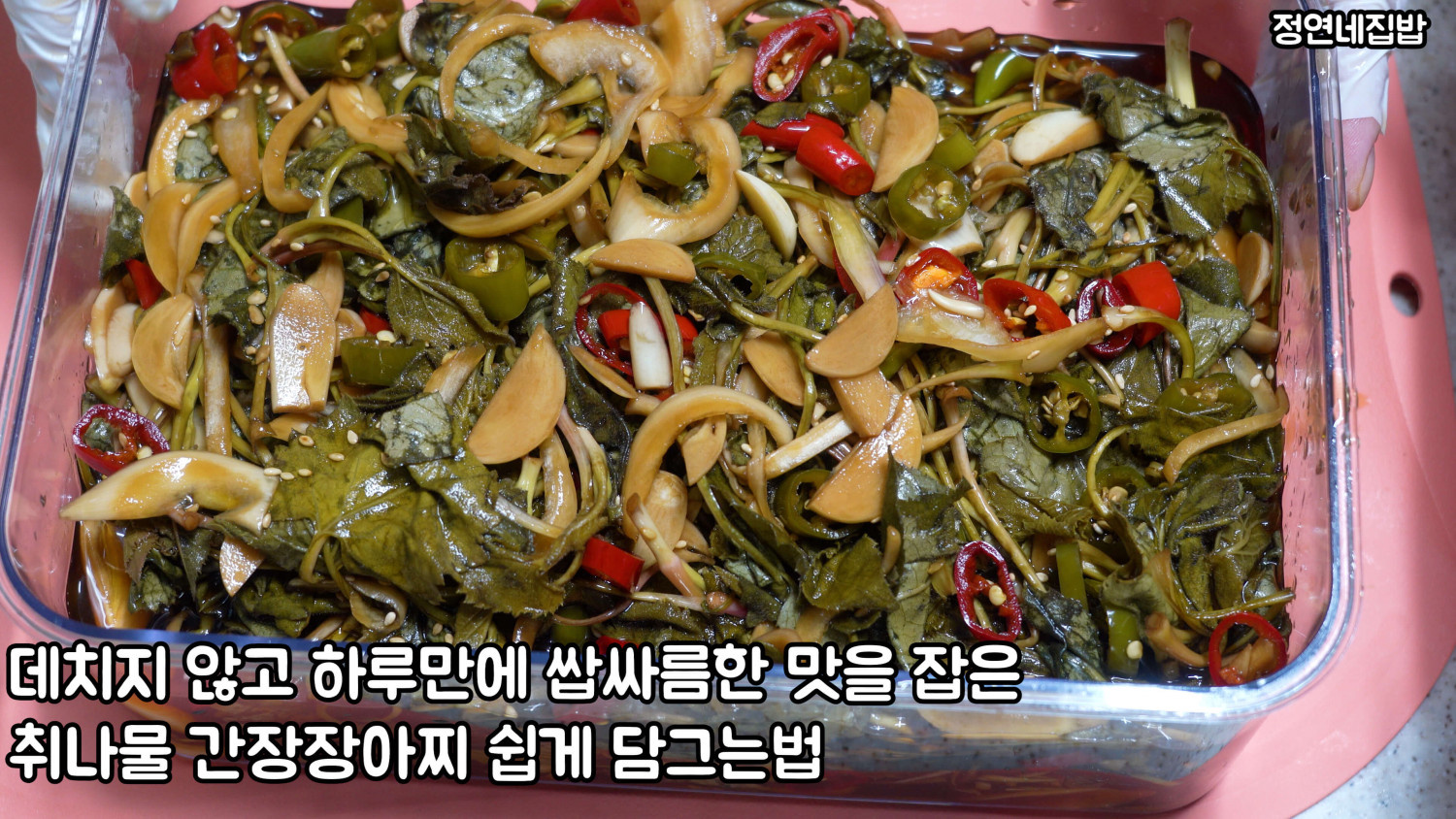Chwinamul (Aster Scaber) Soy Sauce Pickles: A Day-Old Secret Recipe
How to Easily Make Chwinamul Soy Sauce Pickles in One Day, Capturing its Slightly Bitter Taste Without Blanching

Chwinamul can be enjoyed blanched and seasoned, but when it’s young and tender, it makes for a delicious pickle without needing to be blanched. This recipe offers a quick and easy way to preserve its flavor.
Chwinamul Pickle Ingredients- 1kg Fresh Chwinamul (Aster Scaber)
Vegetables for Pickling- 400g Onion
- 8 Cheongyang Peppers (Spicy)
- 5 Red Peppers (for color)
- 150g Garlic
Chwinamul Pickle Brine Ingredients- 750ml Jin Ganjang (Dark Soy Sauce) – (Approx. 3 beer cups)
- 750ml Anchovy Broth – (Approx. 3 beer cups) (Substitute with water or mirin)
- 750ml Rice Wine or Soju – (Approx. 3 beer cups) (Prevents sogginess)
- 250ml Apple Vinegar – (Approx. 1 beer cup)
- 500ml Corn Syrup – (Approx. 2 beer cups) (Adjust sweetness and moisture)
- 400g Onion
- 8 Cheongyang Peppers (Spicy)
- 5 Red Peppers (for color)
- 150g Garlic
Chwinamul Pickle Brine Ingredients- 750ml Jin Ganjang (Dark Soy Sauce) – (Approx. 3 beer cups)
- 750ml Anchovy Broth – (Approx. 3 beer cups) (Substitute with water or mirin)
- 750ml Rice Wine or Soju – (Approx. 3 beer cups) (Prevents sogginess)
- 250ml Apple Vinegar – (Approx. 1 beer cup)
- 500ml Corn Syrup – (Approx. 2 beer cups) (Adjust sweetness and moisture)
Cooking Instructions
Step 1
① Prepare the Chwinamul: First, inspect the Chwinamul and trim off any tough or woody stems. Removing these tough parts ensures a tender and enjoyable texture in the final pickle.

Step 2
② Wash the Chwinamul Thoroughly: Rinse the prepared Chwinamul under running water three to four times until the water runs clear. This removes any dirt or impurities. The slight bitterness of Chwinamul naturally mellows out as it pickles and matures, so there’s no need to blanch it. Enjoy the fresh, pure taste of Chwinamul by pickling it directly!

Step 3
③ Prepare the Pickling Vegetables: Chop the vegetables that will add flavor and texture to your Chwinamul pickles. Slice the onion (400g) into thick strips for sweetness and a refreshing crunch. Thinly slice the Cheongyang peppers (8) diagonally for a spicy kick, and the red peppers (5) diagonally for vibrant color. Thinly slice the garlic (150g) into slivers; this helps distribute its flavor evenly and makes it pleasant to eat with the pickles. These vegetables will infuse the pickles with a wonderful depth of flavor.

Step 4
④ Mix the Flavorful Brine: (Using a standard beer cup as a 250ml/g measure) Pour in 3 cups (750ml) of Jin Ganjang (dark soy sauce) for a deep umami base. Add 3 cups (750ml) of anchovy broth for a savory richness; you can substitute this with plain water or mirin if preferred. To prevent the pickles from becoming soft or mushy, add 3 cups (750ml) of rice wine or soju. For a balanced sweet and sour profile, incorporate 1 cup (250ml) of apple vinegar. Finally, add 2 cups (500ml) of corn syrup to adjust sweetness and moisture; you can also use other sweeteners like rice syrup or fruit syrups. Stir everything thoroughly until the corn syrup is fully dissolved. The alcohol and vinegar are crucial for preserving the pickles without cooking, ensuring they stay crisp and delicious.

Step 5
⑤ One-Day Indoor Maturation: Start by placing the cleaned Chwinamul at the bottom of your pickling container. Layer the prepared vegetables evenly on top of the Chwinamul. The moisture released from the vegetables aids in the pickling process. Pour the prepared brine over the ingredients, ensuring it generously covers the Chwinamul to help reduce its bitterness and enhance flavor. Once the brine is added, place a clean, heavy weight (like a stone or a pickle press) on top to keep the ingredients submerged. Cover the container and let it ferment at room temperature. Since Chwinamul pickles relatively quickly, after about 12 hours, carefully turn the ingredients over to ensure even brining. This process allows the pickles to be ready to eat within a day.

Step 6
⑥ Maturation Complete! Refrigeration and Serving Suggestions: After a day of maturation, open the container to reveal your delicious Chwinamul pickles, which should be beautifully infused with flavor thanks to the turning. While simply tasting them as is is wonderful, these pickles are also a fantastic accompaniment when your appetite is lacking or when enjoying grilled meats. To avoid them being too salty, carefully remove the Chwinamul from the brine and store them separately. Keep the brine in a separate container in the refrigerator. This separation allows you to enjoy the pure taste of Chwinamul while controlling the saltiness. If the brine tastes too concentrated, you can dilute it with a bit of water or broth. The leftover brine can also be used to add depth to other dishes. While you can enjoy them as is, you can also lightly season the pickles for an even more flavorful dish. A simple seasoning recipe follows.

Step 7
⑦ Chwinamul Pickle Salad (Optional) – A Delectable Variation: To make a Chwinamul pickle salad, take a portion of your matured pickles and mix them with a few extra ingredients. Add 1 Cheongyang pepper (chopped) for extra heat, 1 red pepper (chopped) for color, a small amount of chopped green onion or scallion, a little minced garlic, a drizzle of sesame oil, and a sprinkle of sesame seeds. Gently toss these ingredients with the Chwinamul pickles to create a savory and wonderfully seasoned salad. During Chwinamul season, it’s great for stir-frying when dried or enjoying as pickles and salads. Explore these delicious ways to savor Chwinamul!




